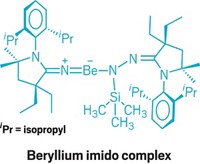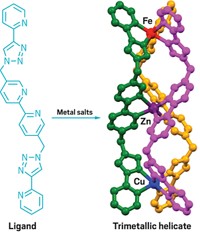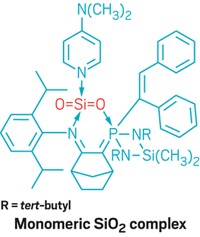Advertisement
Grab your lab coat. Let's get started
Welcome!
Welcome!
Create an account below to get 6 C&EN articles per month, receive newsletters and more - all free.
It seems this is your first time logging in online. Please enter the following information to continue.
As an ACS member you automatically get access to this site. All we need is few more details to create your reading experience.
Not you? Sign in with a different account.
Not you? Sign in with a different account.
ERROR 1
ERROR 1
ERROR 2
ERROR 2
ERROR 2
ERROR 2
ERROR 2
Password and Confirm password must match.
If you have an ACS member number, please enter it here so we can link this account to your membership. (optional)
ERROR 2
ACS values your privacy. By submitting your information, you are gaining access to C&EN and subscribing to our weekly newsletter. We use the information you provide to make your reading experience better, and we will never sell your data to third party members.
Synthesis
All-Metal Sandwich Is Now On The Menu
Inorganic Clusters: A prismatic gold-antimony complex sets a precedent for metallocene-like molecules
by Stephen K. Ritter
August 31, 2015
| A version of this story appeared in
Volume 93, Issue 34
Sandwich complexes in which a metal center is bound by two arene ligands have captured the imagination of chemists ever since the first example, ferrocene, Fe(C5H5)2, was reported in 1951. Besides being cool molecules, a variety of these “metallocene” compounds of different shapes, sizes, and compositions have found applications in catalysis and as building blocks to make new chemicals and materials. A research team in China has now introduced a new item on the molecular sandwich menu: the first all-metal aromatic sandwich complex, [Au3(Sb3)2]3–. The triple-layered prismatic anion consists of a triangular Au3 cluster between two triangular Sb3 clusters (J. Am. Chem. Soc. 2015, DOI: 10.1021/jacs.5b07730). Hua-Jin Zhai of Shanxi University, Zhong-Ming Sun of the Chinese Academy of Sciences’ Changchun Institute of Applied Chemistry, and coworkers made the complex by treating a gold phosphine compound with an ethylenediamine solution of K5Sb4 containing the chelating agent 2,2,2-cryptand. The team found that the new sandwich, isolated as a potassium cryptand salt, is held together by Au–Sb σ bonds and that the antimony rings have π aromatic character. “We believe the complex should pave the way for syntheses of new classes of sandwich compounds and may find technological applications, such as in low-temperature nanogold catalysis,” Zhai says.





Join the conversation
Contact the reporter
Submit a Letter to the Editor for publication
Engage with us on Twitter